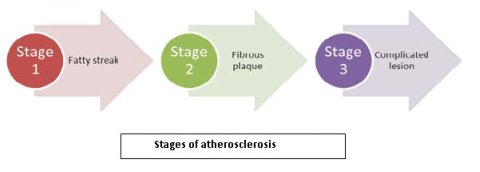Understanding Stages of Atherosclerosis
Researches have proved that there are three different stages of atherosclerosis, although the specific pathological development of atherosclerosis is not well known yet.
However, it has been shown a link between atherosclerosis and high cholesterol.
Therefore, once you optimize your cholesterol, you will be able to get rid of any problem related to the stages of atherosclerosis.
Coming back to atherosclerosis, the first of stages of atherosclerosis is the formation of the fatty streak on the endothelial lining (inner layer) of the arteries.
This is the early clue of development of atherosclerosis; it can be started in childhood (from 1 year old) and from the early years of adulthood (10-14 years old).
The fatty streak looks like a yellow-white strip wondering in your blood circulation in the main arteries, like Aorta.
These fatty streaks are composed mainly of smooth muscle cells, which are saturated with cholesterol besides macrophages (they are a type of white blood cells found in your natural immunity system that act as a scavenger to remove hazards from your blood , like the accumulated cholesterol molecules).
There are no clinical manifestations of the fatty streaks alone, because these streaks are flat and small, thus can’t influence the blood circulation. However, these can grow into a more dangerous form known as fibrous plaque.
Nowadays, there is no way to diagnose the early presence of fatty streaks in your arteries; they are usually detected accidentally during a routine autopsy.
Thanks to macrophages, not all fatty streaks will develop to atherosclerotic plaque. The best way to prevent the formation of fatty streaks is to control your blood cholesterol level by avoiding fatty foods or taking the proper drug medication.
The formation of a fibrous plaque in the inner wall of the arteries is the second of stages of atherosclerosis. Plaque consists also of a huge number of macrophages, smooth muscle cells and lymphocytes.
Unfortunately, all these types of cells are completely filled with accumulated cholesterol, thus have a foamy appearance under microscope.
In this stage, fibrous plaque can grow causing narrowing of the lumen of the arteries as well as stagnation of blood flow in them. Furthermore, fibrous plaques can increase in size until they actually block the affected arteries.
The atherosclerotic fibrous plaque are composed of 3 different layers:
• The atheroma, which is found in the form of nodules formed from the accumulation of macrophages (filled with cholesterol) in the core of a big atherosclerotic plaque.
• Areas of cholesterol particles lying beneath atheroma
• Area of calcification around the outer border of old plaque.
Eventually the final stage of atherosclerosis will start when a fibrous plaque ruptures, revealing the cholesterol and C.T layer under it, thus provoking an intense blood coagulation reaction (leading to the formation of multiple blood clots or thrombi).
The resultant mesh-work of fibrous plaque and the blood clots is famous as a complicated lesion of atherosclerosis. This stage is chronic and progress slowly, as many factors contribute in its development (cumulative process).
Clinically, this stage can be manifested by:
1 - Coronary artery thrombosis
2 - Myocardial infarction or heart attack
3 - Cerebro-vascular stroke
4 - Claudication
As the final treatment for atherosclerotic disease is not established yet, however, action is need in preventing the disease onset. Breaking the cholesterol-related chains of disease is an important step.
Click here to find out a natural formula that will help lowering your BAD (LDL) cholesterol, thus, breaking the chains of development of atherosclerosis stages.
Related topics:
- How to recognize the Atherosclerosis Symptoms in time according to different Stages of Atherosclerosis?
- Get to know the most common Causes of Atherosclerosis.
- How to survive the Atherosclerosis Disease?
- The real secret to successfuly planning an Atherosclerosis Diet.
What is recently discussed in the Cholesterol Questions and Answers Room:






New! Comments
Have your say about what you just read! Leave me a comment in the box below.